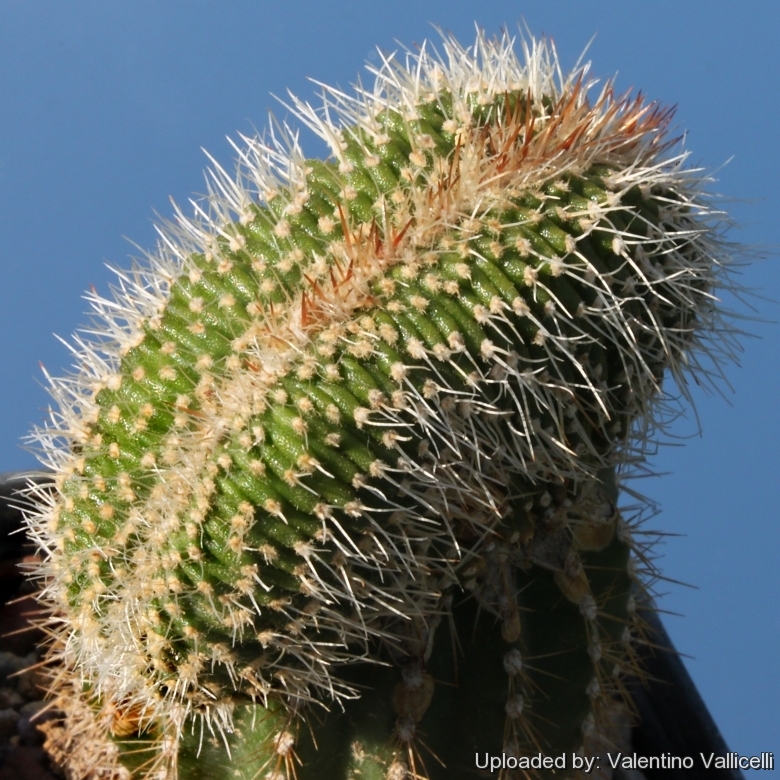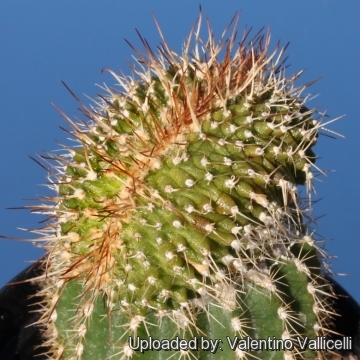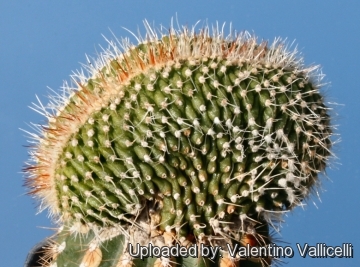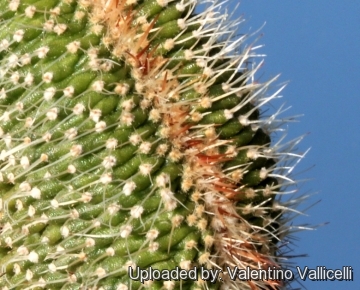Accepted Scientific Name: Uebelmannia gummifera
Succulenta (Netherlands) 161, 1967

Uebelmannia gummifera subs. meninensis f. cristata Photo by: Valentino Vallicelli
Origin and Habitat: Garden origin (Nursery produced cultivar) This plant was originally found in Brazil (mountain of Minas Gerais) where it often grows at very high altitudes.
Habitat: In nature it grows in cracks between rocks or on the rocks themselves, usually where there is a very high degree of atmospheric moisture, which compensates for the fact the soil is perfectly drained. In its natural habitat the plant frequently grows among lichens, which may even cover it.
Synonyms:
See all synonyms of Uebelmannia gummifera
back
Accepted name in llifle Database:Uebelmannia gummifera (Backeb. & Voll) BuiningSucculenta (Netherlands) 161, 1967Synonymy: 12
back
Description: Uebelmannia meninensisSN|14307]]SN|14307]] is a short columnar usually solitary cactus.
Stem: Globular when young, later becoming elongated and cylindrical, greyish-green or reddish-green (f. rubra), 10 cm wide, 45-50 cm tall (In cultivation the colour of the plants depends on sun exposure, the plants grown in shadow are greener, wile the ones in full sun take a purple color)
Ribs: When fully mature it has up to 40 prominent markedly tuberculate, but initially it has considerably fewer.
Tubercles: The tubercles protrude about 8 mm, are separated by transverse grooves and have apical areoles.
Areoles: Close set.
Central spines: 2 or 3, 2 cm long, pointing downward except for the upper one, which is shorter.
Radial spines: Absent.
Flowers: Diurnal yellow. They are up to 2-4 cm long , 2-4 cm in diameter.
Blooming season: Flowers come sporadically from early summer to late summer.
Fruit: Inconspicuous, dark red and globular.
Subspecies, varieties, forms and cultivars of plants belonging to the Uebelmannia gummifera group
Bibliography: Major references and further lectures
1) Edward Anderson “The Cactus family” Timber Press, Incorporated, 2001
2) James Cullen, Sabina G. Knees, H. Suzanne Cubey "The European Garden Flora Flowering Plants: A Manual for the Identification of Plants Cultivated in Europe, Both Out-of-Doors and Under Glass" Cambridge University Press, 11/Aug/2011
3) David R Hunt; Nigel P Taylor; Graham Charles; International Cactaceae Systematics Group. "The New Cactus Lexicon" dh books, 2006Jackie M. Poole, William R. Carr, Dana M. Price, Jason R. Singhurst “Rare plants of Texas: a field guide” Texas A&M University Press, 30/Dec/2007
 Uebelmannia gummifera subs. meninensis f. cristata Photo by: Valentino Vallicelli
Uebelmannia gummifera subs. meninensis f. cristata Photo by: Valentino Vallicelli Uebelmannia gummifera subs. meninensis f. cristata Photo by: Valentino Vallicelli
Uebelmannia gummifera subs. meninensis f. cristata Photo by: Valentino Vallicelli Uebelmannia gummifera subs. meninensis f. cristata Photo by: Valentino Vallicelli
Uebelmannia gummifera subs. meninensis f. cristata Photo by: Valentino VallicelliSend a photo of this plant.The gallery now contains thousands of pictures, however it is possible to do even more. We are, of course, seeking photos of species not yet shown in the gallery but not only that, we are also looking for better pictures than those already present.
Read More... Cultivation and Propagation: This tropical genus, which is hardly ever cultivated except in very specialized collections, prefers loves warm moist, humid conditions and mist spraying is a must in summer. Water regularly during the growing season and use a very draining mineral potting substrate. At the onset of winter, do not water. Uebelmannias need heat all year round and extra winter heat, minimum 10C is best. Avoid any frost. Keep cool in summer. This plant prove to be root prone if kept too cold in winter. To help stop this a good deep collar of pumice or lava grit is an excellent idea. It prefers a full sun position and possibly afternoon shade in summer. If you can place it so that this occurs the plant will be much happier.
Propagation: Grafting since cutting root hardly. Plants are usually grafted onto column-shaped cacti but proved to be able to produce their own roots if degrafted.













